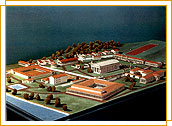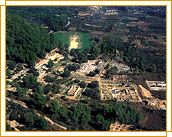Olympia through the centuries
Olympia lies in a distance of 10km from the sea in the area of Elis, in northwest Peloponnese, close to the confluence of the rivers Alpheus and Kladeus.  Peloponnese was considered to be the island of the mythic hero Pelops, who, according to tradition, was associated with Olympia. Near the point of confluence of the two rivers there was a low pine hill, Cronios hill, which took its name from Zeus' father, Cronus. The hill was on the north side of the sanctuary, the Altis, which means "grove" in the dialect of Elis. Ancient writers mention that the Altis was filled with olive trees. Peloponnese was considered to be the island of the mythic hero Pelops, who, according to tradition, was associated with Olympia. Near the point of confluence of the two rivers there was a low pine hill, Cronios hill, which took its name from Zeus' father, Cronus. The hill was on the north side of the sanctuary, the Altis, which means "grove" in the dialect of Elis. Ancient writers mention that the Altis was filled with olive trees.
At Olympia, the Greeks had built altars in the Altis and they honored Zeus, Cronus, Rea, Gaea, Eileithyia, Themis, Idaeus Heracles and other divinities. From the 6th century BC many temples, elaborate altars and statues decorated the Altis, which was the centre of all the religious activities during the Olympic games.
Olympia went through many changes in the following centuries. It started as a local center of worship and came to be a Panhellenic sanctuary.  During the Geometric and Archaic periods (10th-6th century BC) the sanctuary was restructured, in order to satisfy the continuously increasing needs of the visitors. In the beginning of the 6th century BC the first temple was built and its was dedicated to Hera. Various Greek cities and several wealthy colonies built a series of Treasuries in the sanctuary. During the Geometric and Archaic periods (10th-6th century BC) the sanctuary was restructured, in order to satisfy the continuously increasing needs of the visitors. In the beginning of the 6th century BC the first temple was built and its was dedicated to Hera. Various Greek cities and several wealthy colonies built a series of Treasuries in the sanctuary.
In the Classical period (5th-4th century BC) the complex of the temple was reorganized, in order to include the temple of Zeus, the most magnificent temple in Olympia, with the most prominent devotional statue of the Father of the Gods, the work of the sculptor Pheidias. Furthermore, many secular buildings and athletic facilities were erected.
During the Late Classical period and Hellenistic period, Olympia was decorated with buildings that were dedicated by Philip II, father of Alexander the Great, and other wealthy donors. A lot of new and improved training areas were erected, such as the Gymnasium and the Palaestra.
During the Roman period the sanctuary became renowned and enjoyed imperial privileges. However, due to the general political crisis that characterized the Late Roman times it declined rapidly. In AD 393 Theodosius I, Emperor of the Eastern Roman Empire, abolished the Olympic Games.
|
